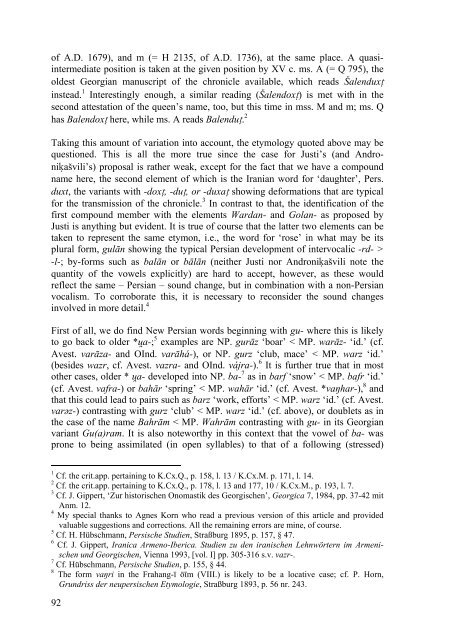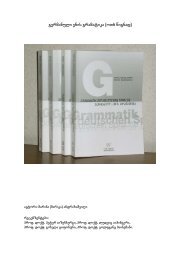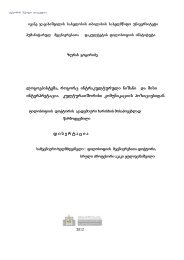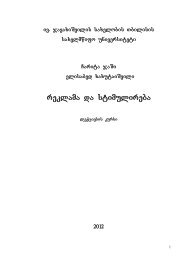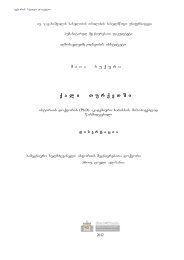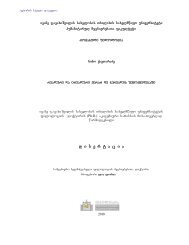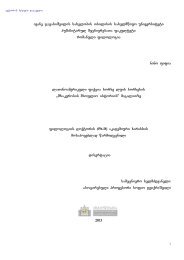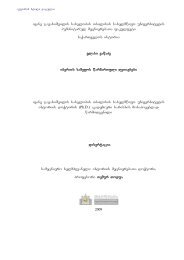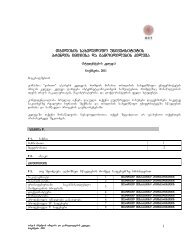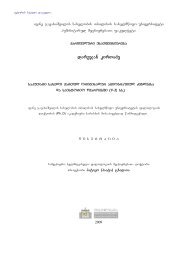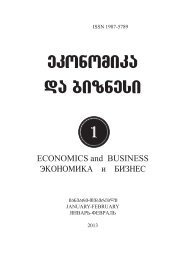issues of linguistics - Tbilisi State University
issues of linguistics - Tbilisi State University
issues of linguistics - Tbilisi State University
Create successful ePaper yourself
Turn your PDF publications into a flip-book with our unique Google optimized e-Paper software.
<strong>of</strong> A.D. 1679), and m (= H 2135, <strong>of</strong> A.D. 1736), at the same place. A quasiintermediate<br />
position is taken at the given position by XV c. ms. A (= Q 795), the<br />
oldest Georgian manuscript <strong>of</strong> the chronicle available, which reads Šalendux÷<br />
instead. 1 Interestingly enough, a similar reading (Šalendox÷) is met with in the<br />
second attestation <strong>of</strong> the queen’s name, too, but this time in mss. M and m; ms. Q<br />
has Balendox÷ here, while ms. A reads Balendu÷. 2<br />
Taking this amount <strong>of</strong> variation into account, the etymology quoted above may be<br />
questioned. This is all the more true since the case for Justi’s (and Androniìašvili’s)<br />
proposal is rather weak, except for the fact that we have a compound<br />
name here, the second element <strong>of</strong> which is the Iranian word for ‘daughter’, Pers.<br />
duxt, the variants with -dox÷, -du÷, or -duxa÷ showing deformations that are typical<br />
for the transmission <strong>of</strong> the chronicle. 3 In contrast to that, the identification <strong>of</strong> the<br />
first compound member with the elements Wardan- and Golan- as proposed by<br />
Justi is anything but evident. It is true <strong>of</strong> course that the latter two elements can be<br />
taken to represent the same etymon, i.e., the word for ‘rose’ in what may be its<br />
plural form, gulān showing the typical Persian development <strong>of</strong> intervocalic -rd- ><br />
-l-; by-forms such as balān or bālān (neither Justi nor Androniìašvili note the<br />
quantity <strong>of</strong> the vowels explicitly) are hard to accept, however, as these would<br />
reflect the same – Persian – sound change, but in combination with a non-Persian<br />
vocalism. To corroborate this, it is necessary to reconsider the sound changes<br />
involved in more detail. 4<br />
First <strong>of</strong> all, we do find New Persian words beginning with gu- where this is likely<br />
to go back to older *u»a-; 5 examples are NP. gurāz ‘boar’ < MP. warāz- ‘id.’ (cf.<br />
Avest. varāza- and OInd. varāhá-), or NP. gurz ‘club, mace’ < MP. warz ‘id.’<br />
(besides wazr, cf. Avest. vazra- and OInd. vájra-). 6 It is further true that in most<br />
other cases, older * u»a- developed into NP. ba- 7 as in barf ‘snow’ < MP. bafr ‘id.’<br />
(cf. Avest. vafra-) or bahār ‘spring’ < MP. wahār ‘id.’ (cf. Avest. *vaŋhar-), 8 and<br />
that this could lead to pairs such as barz ‘work, efforts’ < MP. warz ‘id.’ (cf. Avest.<br />
varəz-) contrasting with gurz ‘club’ < MP. warz ‘id.’ (cf. above), or doublets as in<br />
the case <strong>of</strong> the name Bahrām < MP. Wahrām contrasting with gu- in its Georgian<br />
variant Gu(a)ram. It is also noteworthy in this context that the vowel <strong>of</strong> ba- was<br />
prone to being assimilated (in open syllables) to that <strong>of</strong> a following (stressed)<br />
1<br />
Cf. the crit.app. pertaining to K.Cx.Q., p. 158, l. 13 / K.Cx.M. p. 171, l. 14.<br />
2<br />
Cf. the crit.app. pertaining to K.Cx.Q., p. 178, l. 13 and 177, 10 / K.Cx.M., p. 193, l. 7.<br />
3<br />
Cf. J. Gippert, ‘Zur historischen Onomastik des Georgischen’, Georgica 7, 1984, pp. 37-42 mit<br />
Anm. 12.<br />
4<br />
My special thanks to Agnes Korn who read a previous version <strong>of</strong> this article and provided<br />
valuable suggestions and corrections. All the remaining errors are mine, <strong>of</strong> course.<br />
5<br />
Cf. H. Hübschmann, Persische Studien, Straßburg 1895, p. 157, § 47.<br />
6<br />
Cf. J. Gippert, Iranica Armeno-Iberica. Studien zu den iranischen Lehnwörtern im Armenischen<br />
und Georgischen, Vienna 1993, [vol. I] pp. 305-316 s.v. vazr-.<br />
7<br />
Cf. Hübschmann, Persische Studien, p. 155, § 44.<br />
8<br />
The form vaŋri in the Frahang-ī ōīm (VIII.) is likely to be a locative case; cf. P. Horn,<br />
Grundriss der neupersischen Etymologie, Straßburg 1893, p. 56 nr. 243.<br />
92


